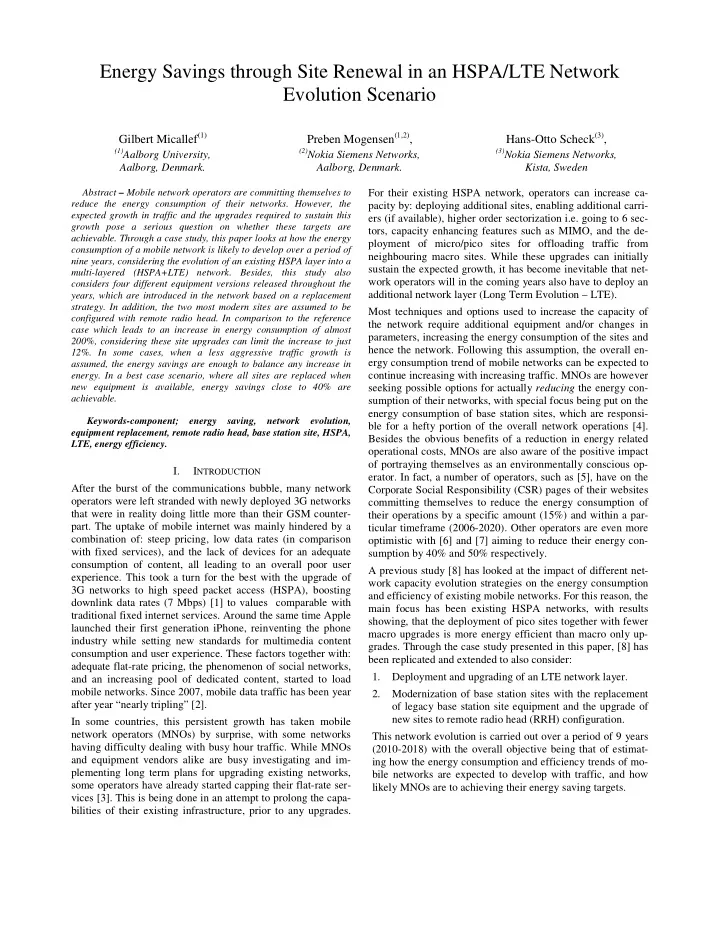

Energy Savings through Site Renewal in an HSPA/LTE Network Evolution Scenario Gilbert Micallef (1) Preben Mogensen (1,2) , Hans-Otto Scheck (3) , (1) Aalborg University, (2) Nokia Siemens Networks, (3) Nokia Siemens Networks, Aalborg, Denmark. Aalborg, Denmark. Kista, Sweden Abstract – Mobile network operators are committing themselves to For their existing HSPA network, operators can increase ca- reduce the energy consumption of their networks. However, the pacity by: deploying additional sites, enabling additional carri- expected growth in traffic and the upgrades required to sustain this ers (if available), higher order sectorization i.e. going to 6 sec- growth pose a serious question on whether these targets are tors, capacity enhancing features such as MIMO, and the de- achievable. Through a case study, this paper looks at how the energy ployment of micro/pico sites for offloading traffic from consumption of a mobile network is likely to develop over a period of neighbouring macro sites. While these upgrades can initially nine years, considering the evolution of an existing HSPA layer into a sustain the expected growth, it has become inevitable that net- multi-layered (HSPA+LTE) network. Besides, this study also work operators will in the coming years also have to deploy an considers four different equipment versions released throughout the additional network layer (Long Term Evolution – LTE). years, which are introduced in the network based on a replacement strategy. In addition, the two most modern sites are assumed to be Most techniques and options used to increase the capacity of configured with remote radio head. In comparison to the reference the network require additional equipment and/or changes in case which leads to an increase in energy consumption of almost parameters, increasing the energy consumption of the sites and 200%, considering these site upgrades can limit the increase to just hence the network. Following this assumption, the overall en- 12%. In some cases, when a less aggressive traffic growth is ergy consumption trend of mobile networks can be expected to assumed, the energy savings are enough to balance any increase in energy. In a best case scenario, where all sites are replaced when continue increasing with increasing traffic. MNOs are however new equipment is available, energy savings close to 40% are seeking possible options for actually reducing the energy con- achievable. sumption of their networks, with special focus being put on the energy consumption of base station sites, which are responsi- Keywords-component; energy saving, network evolution, ble for a hefty portion of the overall network operations [4]. equipment replacement, remote radio head, base station site, HSPA, Besides the obvious benefits of a reduction in energy related LTE, energy efficiency. operational costs, MNOs are also aware of the positive impact of portraying themselves as an environmentally conscious op- I. I NTRODUCTION erator. In fact, a number of operators, such as [5], have on the After the burst of the communications bubble, many network Corporate Social Responsibility (CSR) pages of their websites operators were left stranded with newly deployed 3G networks committing themselves to reduce the energy consumption of that were in reality doing little more than their GSM counter- their operations by a specific amount (15%) and within a par- part. The uptake of mobile internet was mainly hindered by a ticular timeframe (2006-2020). Other operators are even more combination of: steep pricing, low data rates (in comparison optimistic with [6] and [7] aiming to reduce their energy con- with fixed services), and the lack of devices for an adequate sumption by 40% and 50% respectively. consumption of content, all leading to an overall poor user A previous study [8] has looked at the impact of different net- experience. This took a turn for the best with the upgrade of work capacity evolution strategies on the energy consumption 3G networks to high speed packet access (HSPA), boosting and efficiency of existing mobile networks. For this reason, the downlink data rates (7 Mbps) [1] to values comparable with main focus has been existing HSPA networks, with results traditional fixed internet services. Around the same time Apple showing, that the deployment of pico sites together with fewer launched their first generation iPhone, reinventing the phone macro upgrades is more energy efficient than macro only up- industry while setting new standards for multimedia content grades. Through the case study presented in this paper, [8] has consumption and user experience. These factors together with: been replicated and extended to also consider: adequate flat-rate pricing, the phenomenon of social networks, 1. Deployment and upgrading of an LTE network layer. and an increasing pool of dedicated content, started to load 2. Modernization of base station sites with the replacement mobile networks. Since 2007, mobile data traffic has been year after year “nearly tripling” [2]. of legacy base station site equipment and the upgrade of new sites to remote radio head (RRH) configuration. In some countries, this persistent growth has taken mobile network operators (MNOs) by surprise, with some networks This network evolution is carried out over a period of 9 years having difficulty dealing with busy hour traffic. While MNOs (2010-2018) with the overall objective being that of estimat- and equipment vendors alike are busy investigating and im- ing how the energy consumption and efficiency trends of mo- plementing long term plans for upgrading existing networks, bile networks are expected to develop with traffic, and how some operators have already started capping their flat-rate ser- likely MNOs are to achieving their energy saving targets. vices [3]. This is being done in an attempt to prolong the capa- bilities of their existing infrastructure, prior to any upgrades.
Recommend
More recommend